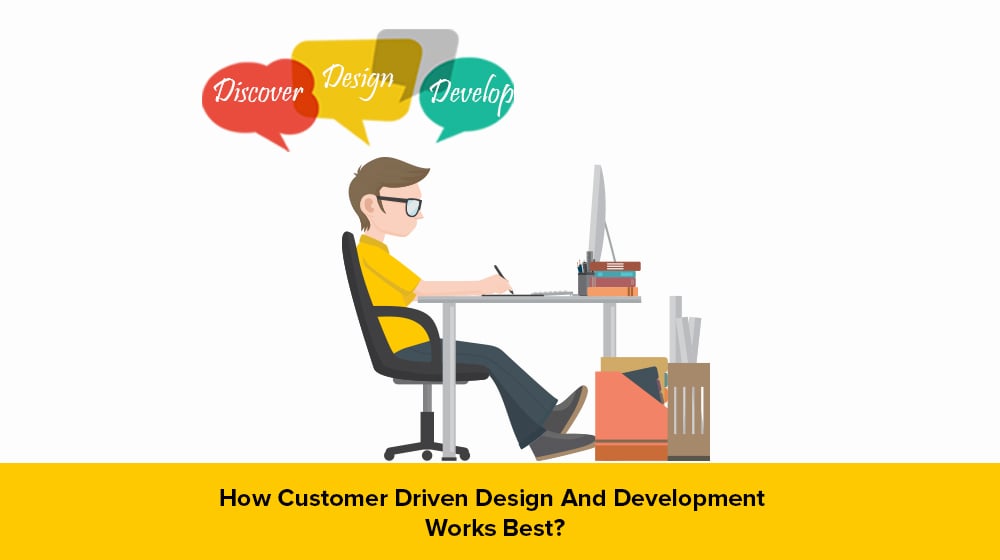-
Customer-driven
-
Why Customer-driven Approach?
-
Advantages of Customer-driven Design
-
Let us consider a simple product Bicycle (Co-created by brands and consumers)
-
Result: Flexible manufacturing, customized products, satisfied customers, better market place, and above all a close tie-up between the brand and the customers.
-
How to be Customer-driven?
-
Capture Amazon’s Culture
-
Now let us see how the Customer-driven approach works for mobile app design and development.
-
Before Designing an App:
-
To Wrap
In 2017, customer experience stands as the top priority for everyone. Gartner predicts that by 2020, more than 40% of all data analytics will relate to customer experience. Experience is the new marketing. Focusing on customers makes the company resilient. The need is to quickly get off the mark and bring customers into the loop. Learn to implement a successful customer-driven design and development process.
Customer-driven
Collecting information about your customers and eventually designing and developing your products and services based on the information gathered is termed as a customer-driven approach. It is all about involving customers’ right from idea to model. Often referred to as a market research-driven approach, the process lets you know your customer at the most granular level.
Why Customer-driven Approach?
- Digital services are creating a revolution in the way we engage with customers.
- Customer experience and feedback can help in iterating products, services; their accessibility, functions, and price.
- Challenges to make your business more adaptable, productive, and intelligent.
People, data, and processes are functioning together today. Businesses of all industries are becoming customer-centric. Although customization came in way back, there has been an increasing interest and effort towards co-creating products in recent days.
If you are a customer-driven company, you can design and develop quality functional products and services.

Advantages of Customer-driven Design
Designing a product according to the needs and desires of customers guarantees not only a niche market but also helps in sustaining a better relationship with customers, reducing risk, and increasing success rate.

Create a culture around your customers and their needs. This does not end with just offering great customer service; rather it talks more about customer experience right from the day they learn about your brand, their buying experience, and their journey with you throughout. Customers become the core of your business. Be open to any conceivable idea.
Let us consider a simple product Bicycle (Co-created by brands and consumers)
The first bicycle was designed by German Baron Karl von Drais, a civil servant to the Grand Duke of Baden in Germany, back in1817. Drais patented this design in 1818 and made it commercially available by nicknaming it as a dandy horse. Several variants were designed as which included; Boneshaker; The Phantom; The high wheel bicycle; English-3 speed etc. Eventually, the famous mountain bike came into existence in 1970.

From mere status symbol, the product has evolved over the years and today we see several styles, types with diverse components catering to different needs of the customers. Whether you want one for comfort, traveling, stunts, or for serious sports, whether you want them with suspension, front or rear, or without suspension, you have them. Components include steel, aluminum, fiber, and so on. They are with brakes, with rim or disc brakes, without brakes, high seat, low seat, with attachments for accessories, without, colorful, plain, for girls/boys, economic/branded, and so on and so forth. Customers played a defining role in bringing thousands of permutations and combinations by specifying such a high level of requirements in terms of, functionality, looks, and utility.
Tell us what do you want; we will create
Back in 1990, the National Bicycle Industrial Company Ltd in Kokubu, Japan took the lead in creating a world of mass-produced diversity. This bicycle company initiated made-to-order bicycles on an assembly line, each fitted to a customer’s measurements and preferences and delivered within two weeks. The line then offered 11,231,862 variations, at prices barely a few percentages higher than the ready-made models. Koji Nishikawa, national’s sales manager reportedly said, “Our idea was to make a separate model for every customer.” The company boldly lined up for the new era for being customer-driven.
Result: Flexible manufacturing, customized products, satisfied customers, better market place, and above all a close tie-up between the brand and the customers.
How to be Customer-driven?
Businesses have moved from merely satisfying their customers to systemically involving customers right into the design and development. Success lies in focusing on your customers and exceeding the expectations of your customers.

- Prioritize customers
- Listen to customers
- Create more ways to engage with customers
- Find evangelists
- Take constant feedback
- Involve in market research
- Make use of Smartphone sensors as it gives a 360-degree view of your customers move and preferences
- Capture and use data to refine your service
- Create conversational UI
- Create Chatbots for customer support
Capture Amazon’s Culture
Amazon, the global retail brand stands today as the top-rated customer-driven company. The company has been offering superior customer experience by adopting a diagnostic approach towards its customers’ past and present journey with the company. From day one of their launch, the company has been working keeping customers as its focal point. The company has been growing and reinventing only by being obsessed with customers.
We’re not competitor obsessed, we’re customer obsessed. We start with the customer and we work backwards – Jeff Bezos
Now let us see how the Customer-driven approach works for mobile app design and development.
Mobile apps are at the forefront of the digital transformation. Designing and developing mobile apps have also evolved over the years. Customers play a vital role. Ideas are launched based on the requirements of customers. Such ideas are developed and services are designed based on the input provided by the customers. Mobile app design, development, and delivery should focus to bring outstanding experience that can delight your customers.
Michael Maoz, a research vice president, and distinguished analyst at Gartner Research rightly mentioned, “No degree of adherence to the latest technology trends will erase the loss of trust engendered by poor customer process management. Maybe this is the age when we finally demonstrate that we ‘listen to the customer?’”

Building top-class mobile experience is the greatest challenge faced by many developers today. Mobile app design and development are different from website design. One cannot have a single strategy for both. Here the development process needs to be faster, must cater to the needs of the targeted customers, and should produce high-quality experience. Above all, it should have space to iterate and improve with evolving requirements.
Before Designing an App:
- Conduct short surveys
- Sit through the actual calls that the team has with your customers
- Host a few sessions which can help you to explore more on your idea
- Allow your customers to share their frame of mind
- Create a prototype
- Tailor your design approach by prioritizing the benefit and value
- Be responsive, scalable and user friendly
- Adhere to UI principles
- Gather feedback
- Go for the final design
Measure thousand times and cut once
To Wrap
Right from product development, supply chain till the value chain, measurement is direct. Customers want their app experience to be personal and simple. Experiences are getting very specific. So, just go ahead and train your mind to accomplish the right performance with the help of your own customers. Create a workflow to involve your customers, understand their framework, and hear them. Adopt customer-driven design and development. Your actions impact yourself. Get addicted to customer information, their requirements, and advice as they are the new market makers.








